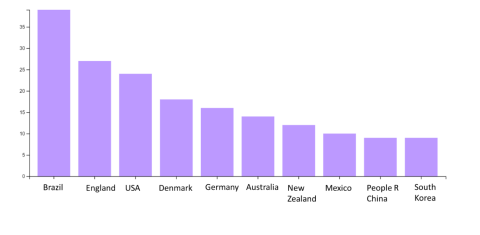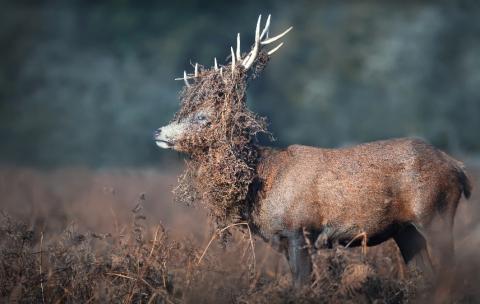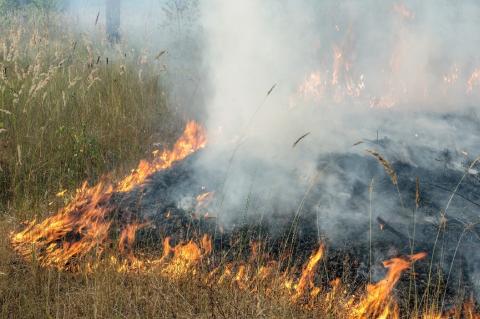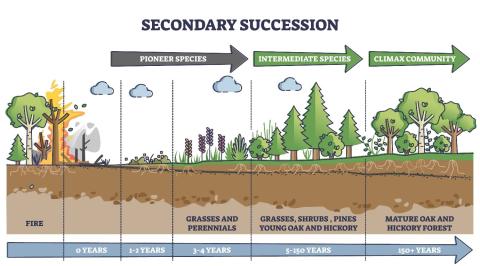18 February 2022
Dr David Cutress: IBERS, Aberystwyth University.
- Bracken is a significant pest problem across the UK and has been for many years
- Bracken outcompetes other vegetation reducing total biodiversity and impacting landscape usage potential for strategies such as grazing or carbon mitigation
- Bracken is further associated with livestock and human disease impacting ticks and producing compounds toxic to livestock, as such reducing its encroachment is key
- For control strategies to be successful they must establish alternative flora with long-term resilience to resist further recolonisation of bracken
Bracken: a UK perspective
Bracken is a highly dominant and competitively successful perennial plant. The main species found throughout Britain is Pteridium aquilinum and more specifically the sub-species aquilinum (though several other sub-species including atlanticum, fulvum, pinetorum and osmundaceum are also present). Bracken is successful as an encroaching plant due to several biological adaptations which assist in its survival and success over other plant species. Bracken produces wide fronds which lead to extremely dense canopies causing severe shading to plant species below, limiting the availability of vital light. Its production of heavy levels of litter suppresses the ability of other plant species to get a foothold for colonisation. Furthermore, bracken has widespread underground rhizome systems which store large quantities of carbohydrates and nutrients and can produce toxic defensive compounds against herbivores, disease infections and directly interfere or suppress the growth of other plants in its vicinity.
Bracken can easily dominate landscapes reducing or preventing productive grazing (due to lack of forage plants and toxicity and carcinogenic compounds) and forestry applications (due to competition for initial growth survival), as well as having impacts on overall biodiversity (through preventing heterogenous plant life which impacts ecosystem variability). As such bracken has been heavily researched with 634 papers found worldwide, a third of which were produced in the last 10 years alone. Specifically, the location of research origins further demonstrates it is a particular problem for the UK landscape.
Number of research Journals last 10 years based on location
As well as direct land usage issues surrounding heavy bracken presence and encroachment there are indications of associations of higher incidence of ticks on livestock (including grouse) and particularly sheep in regions of bracken invasion. The main animal and human tick parasite in the UK is Ixodes ricinus which can cause several zoonose illnesses due to being a vector for disease-causing bacteria (often noted to involve deer reservoirs) such as Lyme disease.
Given that human-associated disease cases of Lyme disease increased by 258% between 2001 and 2011, any reduction in preferable habitats should be considered beneficial. Studies repeatedly highlight that the mat/litter layers formed by bracken act in supporting tick nymphs and as such the cutting and clearing of bracken litter is heavily advised. This is important in areas of managed woodlands as a method of reducing tick levels where people tend to walk regularly for recreational purposes. Furthermore, ticks are known to have a significant impact worldwide on livestock economics and productivity. A recent UK study of tick presence showed that the average tick presence on sheep farms was 13%, and 6% for cattle farms, and that tick-borne disease figures ranged from 6% for sheep farms and 2% for cattle farms. However, in regional hotspots (North Wales, Northwest England and Scotland, including upland farms specifically) figures for tick prevalence could rise to 48-100% and on farms positively reporting ticks, this tick-borne disease figure raised to 44% for sheep farms and 33% for cattle farms. Controlling known tick habitats more effectively could, therefore, have major benefits for the red meat sector.
Current control strategies
The rhizome system of bracken stores large quantities of carbohydrates and nutrients making these plants difficult to control as if these rhizome stores aren’t destroyed, removed or depleted the plant can quickly recover. Current control and management strategies fall into the areas discussed below. The practical applications of these strategies have been previously highlighted in a useful handout. Of note, whilst the herbicide asulam, sold as Asulox, was banned, it is generally granted emergency approval each year through EC regulations. Furthermore, it is undergoing re-registration which was submitted in 2014 and is expected, if successful, to come into effect sometime in 2022 in the UK.
Cutting
Cutting is the earliest documented form of control of bracken and is noted as being the only method up until the 1930s. This was performed via regular manual scything to interfere continuously with the plant’s ability to photosynthesise through its fronds, preventing transport of material to and from the rhizome leading to rhizome death. To note how hardy bracken is, it was stated that for this method to be effective scything was required twice a year for 6 years, however, cutting is still considered effective. Technological progress replaced manual scything with cutting machinery to reduce labour intensity which, whilst effective, was still noted in an 18-year trial to not fully remove all bracken in trial plots.
Ploughing/cultivation
Ploughing and cultivation methods can be effective in the right environments as long as rhizomes are effectively exposed by deep furrows and left overwinter to be degraded by frost. Following ploughing spring sowing is essential to prevent further re-establishment of bracken communities. However, as is well documented across research, ploughing can be detrimental to soil microbiomes and local habitats due to the heavy disturbance this causes with implications on the release of stored nitrogen (N) and carbon (C) from soils negatively impacting agricultural greenhouse gas emission balances.
Crushing, rolling, breaking
Following cutting it was indicated that crushing, also known as rolling, breaking or bruising of bracken was a far easier option particularly on the topography of many of the areas of high bracken encroachment. Whilst the method has proven popular, particularly where the terrain would otherwise damage cutting machinery, there are disputes within research as to the effectiveness of crushing. Some papers demonstrate little to no effect from crushing and others indicate significant effects. Based on the mode of action of crushing being similar to cutting it is likely that the differences occur based on how well the bracken structure is damaged by the specific crushing technique.
Spraying
Spraying herbicides on bracken is also a highly effective method of eradication but these have a series of pros and cons associated. Beneficially, spraying can eradicate bracken immediately in the short-term and, through their ease of application, this requires far lower labour than other methods. Two main herbicide compounds were found to be most successful in managing bracken following a wealth of experimentation from the 1940s to the 1970s, these were glyphosate and asulam. Asulam is preferable of the two as it is far more specific to fern and dock species whereas glyphosate (commonly part of the Roundup® herbicide range) has a far broader impact damaging and killing underlying grasses and other local flora. Glyphosate is also the subject of much legislative activity with regards to its use of late. Asulam, whilst having an effect in single applications, was shown to be most effective with multiple follow up treatments and specific spot treatment. However, due to its targeting, asulam can have off-target impacts on other fern species with research suggesting 50m buffer zones are required to protect other sensitive ferns from spray drift. Furthermore, due to asulam’s high water solubility, it has been demonstrated to remain easily within the environment of soils, this has led to the need to develop specific sensor technologies to assess soil contaminations with this compound. Asulam and variant asulam-sodium have some key considerations based on reports from the European Food Safety Authority particularly concerning ecotoxicity, demonstrating impacts at varying levels on birds and mammals, aquatic organisms (leading to required buffer spray zones and run-off mitigation strategies), bees, sewage treatment and non-target plants. Whilst most impacts are considered low risk, there is evidence of long term studies suggesting these could be underestimated.
In 2020 in the UK the emergency approval of Asulox was only approved for aerial spraying purposes, indicating that such application was deemed more acceptable. This combined with high proportions of bracken dense regions on traditionally difficult to access land suggests that this could be an area where future legislation should consider easing UK specific bans on UAV use for spraying applications.
Miscellaneous
Other methodologies which are discussed, almost offhandedly, are those of burning and livestock grazing management. Where burning is concerned little research evidence is available as to impacts, other than its use as a strategy to remove bracken litter and reference that burning also removes competitor vegetation allowing ease of re-establishment of bracken species. Similarly, when considering grazing with highly selective grazers such as sheep, this leads to the removal of other competitor vegetation and facilitates the further spread of bracken. Cattle are as a less selective grazer and cause more significant physical disruption, being larger thus causing more crushing and trampling of vegetation. Cattle should likely have improved management roles over sheep, or in combination giving support to mixed grazing strategies for the uplands. Current biodiversity projects in Northern Ireland, are seeking to utilise this advantage of cattle grazing by first preparing landscapes via volunteer bracken bashing followed by horse-driven roller flattening of bracken before introducing cattle to the land. Similar volunteer projects are ongoing elsewhere in the UK.
Whatever control strategy is utilised, to avoid the constant need for further bracken removal the management plan must incorporate or encourage the establishment of alternative flora in place of the removed bracken. Flora choice should consider its long-term resilience and stability within the landscape to avoid further recolonization of bracken over time.
Alternative considerations
Bracken plays a considerable role in succession within a landscape. Succession refers to how a biological community changes over time as more species arrive.
Research in the early 2000s noted that bracken, as suspected, had a strong impact on the further succession of other species by outcompeting them. However, a key plant group that has been suggested to have possible roles in reducing bracken’s domination are trees. Tree seedlings during establishment are inhibited by dense bracken, and therefore, tree plantation can only succeed early in a successional community before, or early, in the establishment of bracken. Alternatively, bracken presence should be, at least temporarily, reduced to facilitate the establishment of seedlings. This suggests a possible role for bracken dense regions via the incorporation of trees, which once established, would be competing for resources with bracken and potentially reducing its dominance. Of course, for initial tree establishment one of the physical control processes above would be required to remove the initial competition on tree seedlings but once these were established this should lead to a longer-term land use strategy. Whilst no direct literature could be found indicating tree establishment works as a functional bracken control, which they likely do not based on the indication of a strong preference for bracken in woodland areas, it could make bracken dense land more profitable (whether this is regarding direct produce or carbon credits etc). Currently planting trees in dense bracken is under investigation by a European Innovation Partnership (EIP) Wales project which is initially trying to determine the best bracken clearance method on steep lands common in the region. Whilst early research was hampered by extreme weather, some interesting and innovative clearing practices will be trialled, including lightweight remote-controlled cutting machinery as this avoids some of the access and human risk issues of larger machinery use in steep bracken dense regions. Of course, this strategy could have co-benefits with regards to trees functioning as a good environmental mitigation strategy through sequestering carbon and could even be incorporated with novel produce products such as gourmet birch syrup or similar unique products as a diversified revenue stream. Following the initial reduction of bracken which could allow diversification of flora in these areas, there could be more scope for use as agroforestry silvopastoral systems. Particularly with cattle for the reasons noted above.
Finally, control methods that facilitate the cutting and collection of bracken biomass as a part of their strategies also have implications in the utilisations of a potential waste product. Bracken can be utilised in compost as a good source of potash, as the potentially problematic chemicals it contains are degraded through the composting process. This has been discussed previously for its incorporation alongside sheep’s wool as an alternative output product. Alongside direct compost roles, it has been demonstrated that biochar formation from bracken can lead to improved nutritional profiles in combination with composts. An advantage in considering bracken biochar over composting, in general, would be that the heat exposure ensures the reduction of carcinogenic compounds found in bracken to safe levels in a far shorter timescale.
Summary
Bracken is a highly significant “weed” globally and particularly within the UK climate. Strategies aiming to manage and control its encroachment have been utilised and studied for over a century with many having fundamentally remained the same to this day. Bracken is detrimental to the UK landscape as it actively outcompetes and suppresses local flora reducing biodiversity and removing land from active use which could otherwise supply resources such as sequestering more carbon or being available forage grazing for conversion to protein. Furthermore, bracken produces carcinogenic and toxic chemicals that can impact both humans and animals, and act as a key habitat in the life cycle of zoonosis associated ticks. Management plans and control strategies need to incorporate the replacement of bracken with other resilient flora (such as trees) to avoid consistent recolonisation and increased encroachment.
If you would like a PDF version of the article, please contact heledd.george@menterabusnes.co.uk






